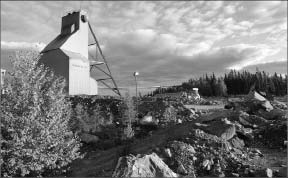A high-grade intercept at the Seabee gold project in Saskatchewan lifted shares of Claude Resources (CRJ-T, CGR-X), on a day that the yellow metal itself was climbing high.
With gold reaching US$1,525 per oz., news of Claude’s intercept increased the company’s shares 3% or 6¢ to $2.21 on 787,000 shares traded in Toronto on May 25 – the day assay results were released.
Results were highlighted by one hole returning 84.66 grams gold per tonne across 3.2 metres. These results came from a follow-up drill program at the Neptune target.
The target sits within the Saskatoon-based company’s wholly owned 144-sq.-km Seabee project. The project, situated 110 km northeast of La Ronge in northern Saskatchewan, also hosts the currently producing Seabee and Santoy 8 gold deposits.
Those two deposits have combined proven and probable reserves of 949,637 tonnes grading 6.82 grams gold for 208,000 oz.
Since beginning production at the site in 1991, the company has turned out 930,000 oz. gold.
The Neptune target was discovered in 2010 and sits 6 km north of the Seabee mine.
Thirteen holes for 4,051 metres were drilled during the winter at Neptune, outlining a gold-bearing structure over a strike length of 1,200 metres and depths of over 250 metres.
“To date, we have only tested the Neptune target on widely spaced centres and are yet to
determine the limits. These results demonstrate the potential for significant new discoveries and resource definition in the Seabee Camp,” Brian Skanderbeg, Claude’s vice-president of exploration, said in a statement.
Skanderbeg also said that the system remains open along strike to the northeast and southwest, and at depth.
Neptune’s expanded exploration program for 2011 includes 26,500 metres of surface drilling, after 10 of 15 holes at Neptune
returned visible gold.
Claude says it will focus drilling on Neptune’s 1.8-km strike length, as well as other targets on the property.


Be the first to comment on "High grades lift Claude"